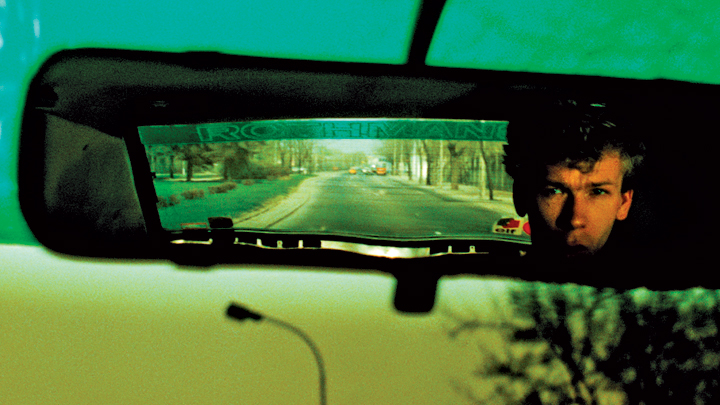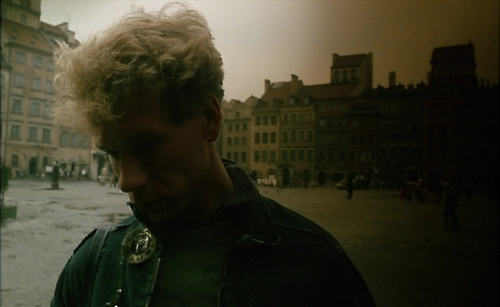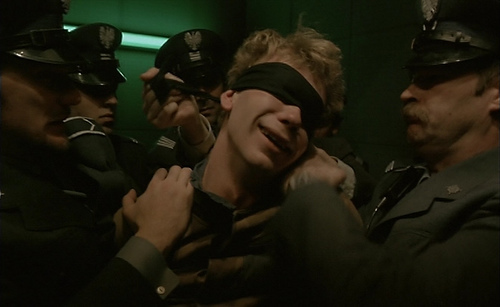How does Kieslowski’s “A Short Film About Killing” use inaction to stir up the viewer?
While violence is at the forefront of “A Short Film About Killing,” the film is also rife with inaction and embraces a slow, deliberate pacing. The prolonging of the titular violence has a strange effect on the viewer. The gradual build creates palpable tension, stirring up a restlessness and desire for violence to finally occur. The result is a film that explores the dark relationship between tension and release, anticipation and catharsis.
In 1988, Krzysztof Kieslowski premiered The Decalogue, a television series that offered modern adaptions of the ten commandments. Much like a traditional parable, the series sought to educate the audience through the moral and ethical issues faced by its principle characters. A Short Film About Killing (1988), the expanded version of The Decalogue‘s fifth episode, focuses on three characters whose lives become intertwined after Jacek Łazar (Miroslaw Baka), a young drifter, decides to murder Waldemar Rekowski (Jan Tesarz), a cynical but unsuspecting cab driver. The film’s pacing grips the viewer unexpectedly, causing us to oscillate between sympathy and disgust. Indeed, this deliberate pacing ends up being the most important tool in Kieslowski’s arsenal; the slowmoving story and sustained inaction create palpable tension, stirring up a restlessness and desire for release in the viewer.
The film’s opening credits establish the macabre mood, which we anticipate because of the film’s title. A dead rat lies amid swirling muddy street water. Several kids run anxiously away from a cat that swings from a noose in the wind. Sławomir Idziak, the prolific cinematographer who collaborated with Kieslowski on two other films, The Double Life of Veronique (1991) and Three Colors: Blue (1993), places a green filter over most of the film. This has a strange effect; it limits the viewer’s visibility while also rendering much of the characters’ motion blurry and distorted. In the book Kieslowski on Kieslowski, the filmmaker says, “if you put a green filter on the camera, the world becomes much crueler, duller and emptier” (Kieslowski 161).

Miroslaw Baka in A Short Film About Killing (1988)
After these initial impressions of muddled hopelessness, we move to our characters. Jacek is seen walking, thinking, turning slowly to look into the wind, and in one instance, scaring pigeons. He strolls into a movie theater and speaks with the attendant only to leave, disinterested. He visits a photo development studio and gets a picture enlarged. He watches police men. All the while, Kieslowski cuts intermittently back and forth to Piotr Ballicki (Krzysztof Globisz), who is engaged in his entry examination to become a public defendant. Though he lacks world experience, he makes up for it through his lexicon of grandiose quotes and ideas. He is confident in his values and virtues, although they have yet to be tested. We also cut to Waldemar Rekowski, who painstakingly washes his taxi, bit by bit, even rejecting clientele to complete the tedious task of polishing. We understand that he is rather cold hearted and selfish. He honks his horn to scare dogs on purpose, laughing afterwards. He admires the legs of a younger woman, Beata, lustfully asking if she needs a ride anywhere. He is ugly and old, but he is aware of his power as a driver, which gives him confidence.
We spend a lot of time waiting for these characters to meet and interact. This time spent waiting and watching leaves the audience feeling a little impatient for action. This impatience driven by inaction is essential to the parable and its ability to affect the audience. Because of the title, we know that someone will die. We have an idea that it will be one of the three characters introduced and followed for the first half of the film. This leaves us waiting to witness the inevitable violence. We wonder when it will happen, how it will be carried out, and for what reasons, if any. By building so much tension through inaction, Kieslowski creates a complex feeling in the viewer. The viewer needs to release his or her tension through the release of violence. That means that the viewer is waiting for death; their mounting impatetience and desire for violence is essential to Kieslowski’s mission. Without even being aware of it, the viewer depends on death as a means of releasing tension.
It’s not until the thirty fifth minute of the film that Jacek meets Waldemar. Jacek lies to other pedestrians who are looking to split the cab with him in order to be alone with the driver. Moments before this, Piotr experiences a sinking feeling and says gravely, “I was just thinking it might not be all that easy,” speaking of his newfound thrill for life and sense of accomplishment at having passed his exams and becoming a public defendant. We learn later that Piotr and Jacek were in the same cafe moments before Jacek enters the cab. Kieslowski intrigues the audience with moments like these, where the actions of one character could have been prevented by another character, if they had only known to act, if they only knew the consequences they will learn later.

A Short Film about Killing (1988)
When the murder finally does occur, it is in a desolate field. The violent scene lasts for seven long minutes. Realizing more than once that Waldemar is not dead, he must continue to choke, beat and bludgeon the man until finally the rock comes smashing down over Waldemar’s blanketed skull.
At this point, the audience receives their dark catharsis. Jacek however, does not. He finds no solace in his actions. While sitting in the stolen cab listening to the radio, he feels frustration at the lyrics, rips out the console and puts his head in his hands. As he is driving along in the following scene, his only possible motive surfaces when he appeals to Beata that they elope. He explains after they both get into the car that “now [they] can go anywhere.” Beata seems uneasy and asks, “Where did you get this car?” It’s obvious she knows what Jacek has done. Among his reasons for making this movie, Kieslowski says “[he] wanted to describe the Polish world, a world which is quite terrible and dull…a world of people living alone. People are very lonely in general, I think, regardless of where they live” (160). Is this loneliness the puppet master behind Jacek’s experiment with death? Kieslowski is presenting a world where people exist alone; one faces a split second chance of companionship, but at the cost of a man’s life.
We cut immediately from the car scene to the end of Jacek’s trial. He is sentenced to death and Piotr’s journey to becoming a public defendant is finished. He is forced to abandon his idealistic tendencies in the face of reality. He must accept that the world is not how he thought it was, that he lost his case and his client will be put to death. It’s at this point that we as the audience understand where the movie will end; once again, we are waiting for death. As we wait, we see the undertaker preparing the hanging chamber. He assiduously applies oil to the winch, making sure the rope will smoothly wind around its shaft, and he places a yellow tray in the space beneath the trap door.

In the final moments before they bring him to the chamber, Jacek is as unwilling to die as was his victim. Piotr sits, listening to Jacek’s horrific recounting of the death of his sister, and we sit, waiting to be released from the film’s second killing. Several times, the guard enters and warns them both that it is time. The guard has taken the place of Jacek from the first murder, and Jacek is now Waldemar, stubbornly hanging on to life, refusing to concede. They both hang on to the very end, extending the anguish and cruelty of the act of killing. Kieslowski illuminates his most important and most simple reason for making this movie in these final scenes. He later says, “It’s wrong no matter why you kill, no matter whom you kill, no matter who does the killing” (160).
This film, rife with inaction, leaves the viewer feeling awful. Awful because of its commentary on humanity and realism, awful because of its slow and mournful hopelessness, awful because of Idziak’s array of distorting filters, and awful because our only deliverance as viewers is death. Jacek had no developed motive. How can we pity him? But how can we not pity him as he smokes his last cigarette in anguish? There is no redemption for humans in Kieslowski’s brutal depiction of this real world. By the end of the film, we have reached the purpose of the parable. The lesson we learn here is Thou Shall Not Kill, not only because we have witnessed the horrifying reality of death, but because, through our anticipatory yearning for violence, the audience is complicit. Our subsequent self-disgust proves the effectiveness of Kieslowski’s mission.
Kieślowski, Krzysztof, and Danusia Stok. Kieślowski on Kieślowski. London: Faber and Faber, 1993. Print.

